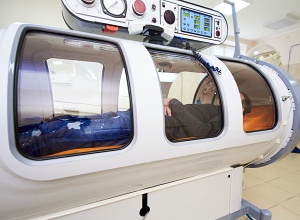An Israeli study indicates that hyperbaric oxygen treatments (HBOT) in healthy ageing adults can stop the ageing of blood cells and reverse the shortening of chromal telomeres. In the biological sense, the adults' blood cells actually grow younger as the treatments progress.
The Tel Aviv University (TAU) and the Shamir Medical Center researchers found that a unique protocol of treatments with high-pressure oxygen in a pressure chamber can reverse two major processes associated with ageing and its illnesses: the shortening of telomeres (protective regions located at both ends of every chromosome) and the accumulation of old and malfunctioning cells in the body. Focusing on immune cells containing DNA obtained from the participants' blood, the study discovered a lengthening of up to 38% of the telomeres, as well as a decrease of up to 37% in the presence of senescent cells.
The study was led by Professor Shai Efrati of the Sackler School of Medicine and the Sagol School of Neuroscience at TAU and Founder and Director of the Sagol Center of Hyperbaric Medicine at the Shamir Medical Center; and Dr Amir Hadanny, Chief Medical Research Officer of the Sagol Center for Hyperbaric Medicine and Research at the Shamir Medical Center. The clinical trial was conducted as part of a comprehensive Israeli research program that targets ageing as a reversible condition.
"For many years our team has been engaged in hyperbaric research and therapy — treatments based on protocols of exposure to high-pressure oxygen at various concentrations inside a pressure chamber," Professor Efrati explains. "Our achievements over the years included the improvement of brain functions damaged by age, stroke or brain injury.
"In the current study we wished to examine the impact of HBOT on healthy and independent aging adults, and to discover whether such treatments can slow down, stop or even reverse the normal aging process at the cellular level."
The researchers exposed 35 healthy individuals aged 64 or over to a series of 60 hyperbaric sessions over a period of 90 days. Each participant provided blood samples before, during and at the end of the treatments as well as some time after the series of treatments concluded. The researchers then analysed various immune cells in the blood and compared the results.
The findings indicated that the treatments actually reversed the ageing process in two of its major aspects: The telomeres at the ends of the chromosomes grew longer instead of shorter, at a rate of 20%-38% for the different cell types; and the percentage of senescent cells in the overall cell population was reduced significantly — by 11%-37% depending on cell type.
"Today telomere shortening is considered the 'Holy Grail' of the biology of ageing," Professor Efrati says. "Researchers around the world are trying to develop pharmacological and environmental interventions that enable telomere elongation. Our HBOT protocol was able to achieve this, proving that the aging process can in fact be reversed at the basic cellular-molecular level."
"Until now, interventions such as lifestyle modifications and intense exercise were shown to have some inhibiting effect on telomere shortening," Dr. Hadanny adds. "But in our study, only three months of HBOT were able to elongate telomeres at rates far beyond any currently available interventions or lifestyle modifications. With this pioneering study, we have opened a door for further research on the cellular impact of HBOT and its potential for reversing the ageing process."
Title: Hyperbaric oxygen therapy increases telomere length and decreases immunosenescence in isolated blood cells: a prospective trial
Authors: Yafit Hachmo, Amir Hadanny, Ramzia Abu Hamed, Malka Daniel-Kotovsky, Merav Catalogna, Gregory Fishlev, Erez Lang, Nir Polak, Keren Doenyas, Mony Friedman, Yonatan Zemel, Yair Bechor, Shai Efrati.
Publication details: Aging, 18 November 2020
DOI: 10.18632
Abstract
Introduction: Aging is characterized by the progressive loss of physiological capacity. At the cellular level, two key hallmarks of the aging process include telomere length (TL) shortening and cellular senescence. Repeated intermittent hyperoxic exposures, using certain hyperbaric oxygen therapy (HBOT) protocols, can induce regenerative effects which normally occur during hypoxia. The aim of the current study was to evaluate whether HBOT affects TL and senescent cell concentrations in a normal, non-pathological, aging adult population.
Methods: Thirty-five healthy independently living adults, aged 64 and older, were enrolled to receive 60 daily HBOT exposures. Whole blood samples were collected at baseline, at the 30th and 60th session, and 1-2 weeks following the last HBOT session. Peripheral blood mononuclear cells (PBMCs) telomeres length and senescence were assessed.
Results: Telomeres length of T helper, T cytotoxic, natural killer and B cells increased significantly by over 20% following HBOT. The most significant change was noticed in B cells which increased at the 30th session, 60th session and post HBOT by 25.68%±40.42 (p=0.007), 29.39%±23.39 (p=0.0001) and 37.63%±52.73 (p=0.007), respectively.
There was a significant decrease in the number of senescent T helpers by -37.30%±33.04 post-HBOT (P<0.0001). T-cytotoxic senescent cell percentages decreased significantly by -10.96%±12.59 (p=0.0004) post-HBOT.
In conclusion, the study indicates that HBOT may induce significant senolytic effects including significantly increasing telomere length and clearance of senescent cells in the aging populations.
[link url="https://www.aging-us.com/article/202188/text"]Full text in Aging (Open access)[/link]

